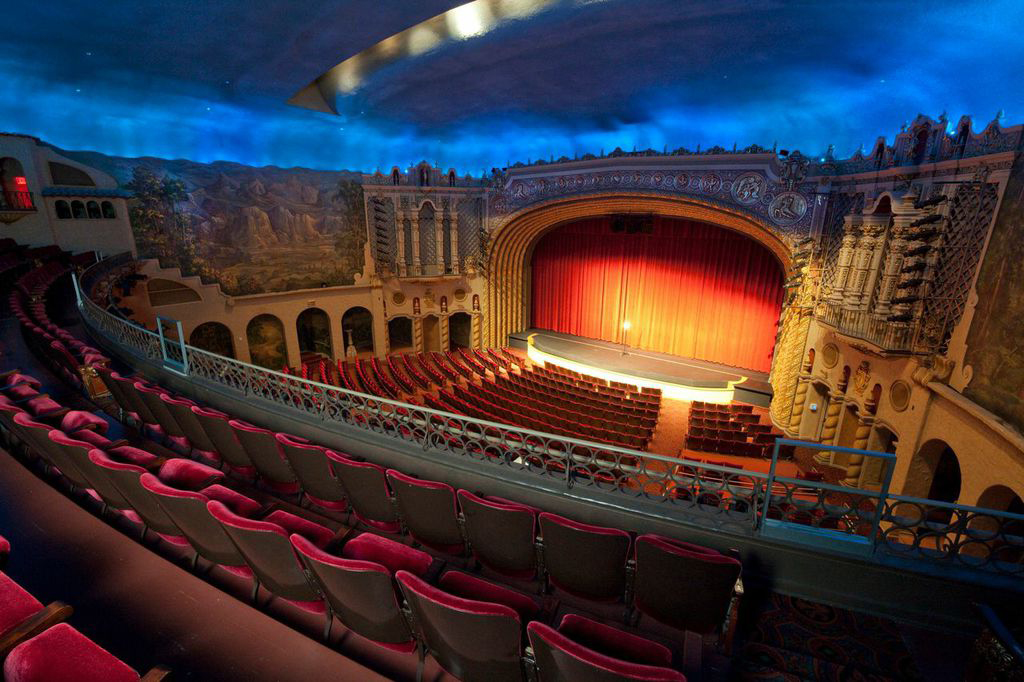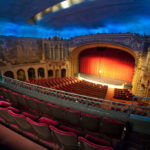Baroque Beauty – The Orpheum Theatre

Writer Paula Theotocatos
Photography Fred Urlich Photography
[dropcap]T[/dropcap]he year was 1929. The madcap era of the Roaring ‘20s was over and the country plunged into the Great Depression with the Wall Street stock market crash. The first Academy Awards ceremony was held in Los Angeles and the Museum of Modern Art opened in New York.
Across the country in Phoenix, another prestigious opening for the benefit of the arts occurred that year: the beautiful Orpheum Theatre.
The Orpheum has a rich history and Anthem resident Fay Giordano, who is a docent at the theater, will be glad to tell you all about it. Fay first became a docent in 1994 when the theater was in the middle of its 12-year renovation.
“We did hard hat tours of the empty theater, telling its history and the plans for its future,” Fay explains. “It reopened in January of 1997 after a $14.5 million restoration.”
Fay has had an interesting history of her own.
“Although I was born in Duluth, I was raised on a farm near the small town of Upsala in Central Minnesota, exactly where Garrison Keillor placed his fictitious town, Lake Wobegon,” she says. She completed an around-the-world tour when she was only 22 via the Trans-Siberian Railway and Eurail Pass, followed by a job on Park Avenue in New York City.
She met her husband, Frank, at the tender age of 19, while she was teaching English as a second language as a Peace Corps volunteer on the Northern Mariana Island of Rota. Frank was a Seabee assigned to build the school library where Fay was also the librarian. After they were married, they moved to St. Croix, U.S. Virgin Islands, and enjoyed what Fay refers to as “our 4.5-year honeymoon.” After their island sojourn, they moved to the San Francisco Bay area for several years and then on to Phoenix in 1993. The peripatetic couple moved again after retirement to Lake Tahoe for a few years, but were drawn back to Phoenix. They moved to Anthem in 2004 and Fay resumed her docent duties at the now-completed Orpheum Theatre.
“After going to a performance at the Orpheum, I knew I had to go back to being a docent there,” Fay says. “It’s just such a beautiful, interesting historic building.
“We do public tours every other Tuesday and private tours by arrangement. I’ve shared the story of the Orpheum with at least eight private tour groups from Anthem.”
After the Orpheum was opened in 1929, it became the venue for vaudeville acts for the next 20 years. After vaudeville died, the theater became a movie house, the Paramount, for about 20 years more, and then the well-known theater impresario, James Nederlander, took it over. It became known as Palace West and was the home to touring Broadway productions. Finally, it was rented by a local family, the Coronas, who showed Spanish language films, boxing matches and talent shows.
The theater then fell into disarray and was to be torn down when the Junior League stepped up in 1985 to ensure the preservation of the historic building. The women of the League held fundraisers and saw that it was placed on the National Register of Historic Places in 1985. After an ambitious 12-year restoration project, the Orpheum reopened in January 1997 with a performance by Carol Channing in “Hello Dolly.”
The design of the building was meant to be atmospheric, suggesting an outdoor mission house garden. It is a blend of Spanish, Italian and Rococo architecture. Over the years, the lobby’s murals and moldings had been painted over and its beauty marred significantly. In order to restore it to its former glory, architectural detectives removed the top layer of paint where they could and worked with old photographs to discover what lay beneath the paint.
Highlights of the tour include:
• The ceiling in the theater’s main hall, which is meant to represent the sky. During the daytime, it displays a blue sky and clouds and then turns mauve as the sky darkens to twilight. Finally, the ceiling turns dark blue with stars scattered over its surface, signaling the performance is about to begin.
• The 1,062 new seats on the first level of the theater and 302 original seats in the balcony.
• The Kissing Room, where you can hear a perfect echo of your voice as you stand in the center of the room. “Performers have been known to practice there,” Fay shares, “and marriage proposals have been made there!”
• The Peacock and Phoenix stairways, along with many artworks referencing ancient Greek theater. “The elliptical Peacock Stairway is probably the most beautiful place in the theater,” Fay says. “Looking up from the lower level, there are several elegant peacocks on the ceiling and under the stairway, done in aluminum leaf with beautifully colored glazing.”
• The ladies’ room, not only for its elegance but also for the fact that it is twice as large as the men’s room. “It affords a much quicker visit than the ladies’ room of most venues,” Fay explains. “The ladies love it and even the men usually say ‘wow’ when they are invited to enter.”
I asked Fay if there were any ghosts in this historic structure.
“Although I’ve never had any experiences myself, there are so many stories that we recently began giving Ghost Tours as a fundraiser for the theater,” Fay shares.
The Orpheum Theatre is a fascinating glimpse into history. In addition to the free public tours every other Tuesday and the private tours by appointment, look for a Ghost Tour around Halloween this coming October. Also in October this year, a silent movie from the 1920s will be shown on the 23rd, accompanied by music on the 1929 Mighty Wurlitzer Theatre Organ.
Starting in September, free concerts will be offered in front of the fireplace by a small group of musicians approximately every other Tuesday, along with complimentary appetizers and a full, no-host bar. As an extra attraction, the docents will also conduct short tours during intermission. Call the Phoenix Convention Center to verify dates.
And don’t leave without stopping by the Friends of the Orpheum Theatre gift counter in the lobby, from which any profits support the theater.
877-840-0457
phoenixconventioncenter.com/orpheum-theatre




